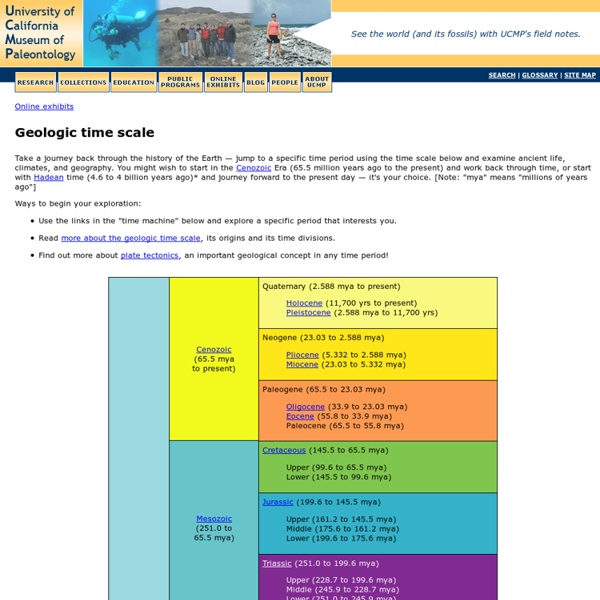



Civil Rights Movement Timeline (14th Amendment, 1964 Act, Human Rights Law) Jan. 23 The 24th Amendment abolishes the poll tax, which originally had been instituted in 11 southern states after Reconstruction to make it difficult for poor blacks to vote. Summer The Council of Federated Organizations (COFO), a network of civil rights groups that includes CORE and SNCC, launches a massive effort to register black voters during what becomes known as the Freedom Summer. It also sends delegates to the Democratic National Convention to protest—and attempt to unseat—the official all-white Mississippi contingent. July 2 President Johnson signs the Civil Rights Act of 1964. Aug. 4 (Neshoba Country, Miss.)
Le site des dinosaures... List of timelines From Wikipedia, the free encyclopedia This is a list of timelines currently on Wikipedia. §Types[edit] §General timelines[edit] §History[edit] §Arts[edit] §Biographical timelines[edit] §Crime[edit] §Events[edit] §Disasters[edit] §Economics[edit] §Entertainment[edit] §Environmental issues[edit] §Fiction[edit] §Geographical timelines[edit] Timeline of country and capital changes §Ancient civilizations[edit] §Extant civilizations[edit] §Supranational entities and regions, peoples[edit] §Sovereign states[edit] §Subnational regions and cities, narrow timelines[edit] §Law[edit] §Military[edit] §Military conflicts[edit] §Philosophy[edit] §Politics[edit] §Religion[edit] §Ayyavazhi[edit] Timeline of Ayyavazhi history (1809–present) §Buddhism[edit] Timeline of Buddhism (563 BCE – present) §Christianity[edit] §Islam[edit] §Jainism[edit] Timeline of Jainism §Judaism[edit] §Sikhism[edit] Sikh Gurus (1469–1666) §Science[edit] §Astronautics and planetary science[edit] §Astronomy, Astrophysics, and Cosmology[edit] §Biology[edit] §Sports[edit]
Préhistoire Préhistoire Une page pour visualiser d'un seul coup d'oeil les grands événements de la Préhistoire, son histoire, son étude, et aussi celle de l'Homme et de ses ancêtres : les hommes préhistoriques. Préhistoire, une histoire récente... Un peu d'histoire de la Préhistoire... Cela fait maintenant presque deux siècles que l'homme étudie cette période chronologique qui s'étend sur plusieurs millions d'années : la Préhistoire. La vérité vient de la géologie Les études géologiques commencent alors à faire reculer l'âge de la Terre. Histoire de la Terre Les théories de l'évolution Préhistoire - les grandes avancées Le schéma ci-dessous vous présente les avancées majeures de la préhistoire, ou du moins celles dont on a pu trouver et identifier les traces ! Schéma Copyright Neekoo Les premiers outils - 2,5 Millions d'années puis les premiers bifaces vers - 1,3 millions d'années L'une des premières preuves de l'activité humaine qui soit parvenue jusqu'à nous est l'industrie lithique. Yves Coppens
Brief Timeline of American Literature and Events, 1620-1920 Brief Timeline of American Literature and Events: Pre-1620 to 1920 This timeline provides a short chronology of events in American history and literature. It is linked to course pages and bibliographies as well as to a set of more general linked resources: pages on American authors, literary movements, and American literature sites. Each author page contains a picture (if available), a bibliography (if available), links to major sites about the author, and links to works online.
A Guide to the Orders of Trilobites Food Timeline: food history research service Internet Sites généraux sur l'évolution Evolution de l'origine de la vie aux origines de l'homme : Un dossier du centre National de la Recherche Scientifique aborde le sujet par une dizaine d'articles écrits par des spécialistes. Ne râter pas la videothèque et les arbres phylogénétiques. L'évolution le grand récit du vivant : Les Vidéo et les documents d'un cycle de conférences organisées par le Citée des Sciences en 2007. Paleontologia electronica : une revue de paléontologie en ligne, avec des images, bien sur, mais aussi des animations. Les articles ont des résumés en français. Planète Terre par P. CMP Web Time Machine : Une bible! PALAEOS: The Trace of Life on Earth : Le cladogramme du monde vivant. Paléontologie humaine De superbes réalisations du Ministère de la Culture Tautavel, la Caune de l'Arago La Grotte Chauvet La grotte de Lascaux Ce site fourmille d'articles, de dossiers et d'informations actualisées sur l'histoire de la lignée humaine, l'art préhistorique et la théorie de l'évolution.
Geologic Time Scale - Geological Time Line - Geology.com Dividing Earth History into Time Intervals Geologists have divided Earth's history into a series of time intervals. These time intervals are not equal in length like the hours in a day. Instead the time intervals are variable in length. This is because geologic time is divided using significant events in the history of the Earth. Examples of Boundary "Events" For example, the boundary between the Permian and Triassic is marked by a global extinction in which a large percentage of Earth's plant and animal species were eliminated. Eons are the largest intervals of geologic time and are hundreds of millions of years in duration. Eras Eons are divided into smaller time intervals known as eras. Periods Eras are subdivided into periods. Epochs Finer subdivisions of time are possible and the periods of the Cenozoic are frequently subdivided into epochs. Our geologic time scale was constructed to visually show the duration of each time unit. Contributor: Hobart King More Geologic Time Scale Resources